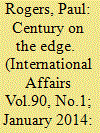| Srl | Item |
| 1 |
ID:
173463


|
|
|
|
|
| Summary/Abstract |
This article uses the mean age at menarche of women in China as an indicator of changes in the standard of living during the 20th century. It discusses the difficulties of using this indicator. It finds that the mean age of menarche stagnated at 16 to 17 years for women born during the period between the 1880s and 1930s. The age at menarche decreased in some urban areas, indicating improving living standards in, for example, Beijing and Shanghai. The mean age at menarche increased for 1940s’ birth cohorts, in relation not only to the warfare of the 1940s but also the famine of 1959–1962. The mean age at menarche decreased in a sustained way for women born during the 1950s to early 2000s. The decrease is associated with increasing educational attainment since the 1940s and also improvements in nutrition, hygiene and healthcare.
|
|
|
|
|
|
|
|
|
|
|
|
|
|
|
|
| 2 |
ID:
131417


|
|
|
|
|
| Publication |
2014.
|
| Summary/Abstract |
The article argues that the century from 1945 is likely to prove seminal in terms of human progress. It marks the period when the human community has to come to terms with its capacity for self-destruction through the invention of weapons of mass destruction and its ability to exceed the homeostatic capabilities of the global ecosystem in an era of deep socio-economic divisions. Two-thirds of the way through this century the progress has been mixed. Nuclear war has been avoided more by luck than by wisdom, there remain risks of nuclear proliferation and it is not evident that humankind has acquired the ability to deal with the destructive potential of bio-, nano- and other emerging technologies. Recognition of the extent of anthropogenic impacts on ecosystem stability is evident, but not at the level necessary for the radical responses required. Even so, there are signs of progress and potential for change, suggesting that the final one-third of the century will be singularly important in ensuring long-term emancipation and environmental sustainability.
|
|
|
|
|
|
|
|
|
|
|
|
|
|
|
|